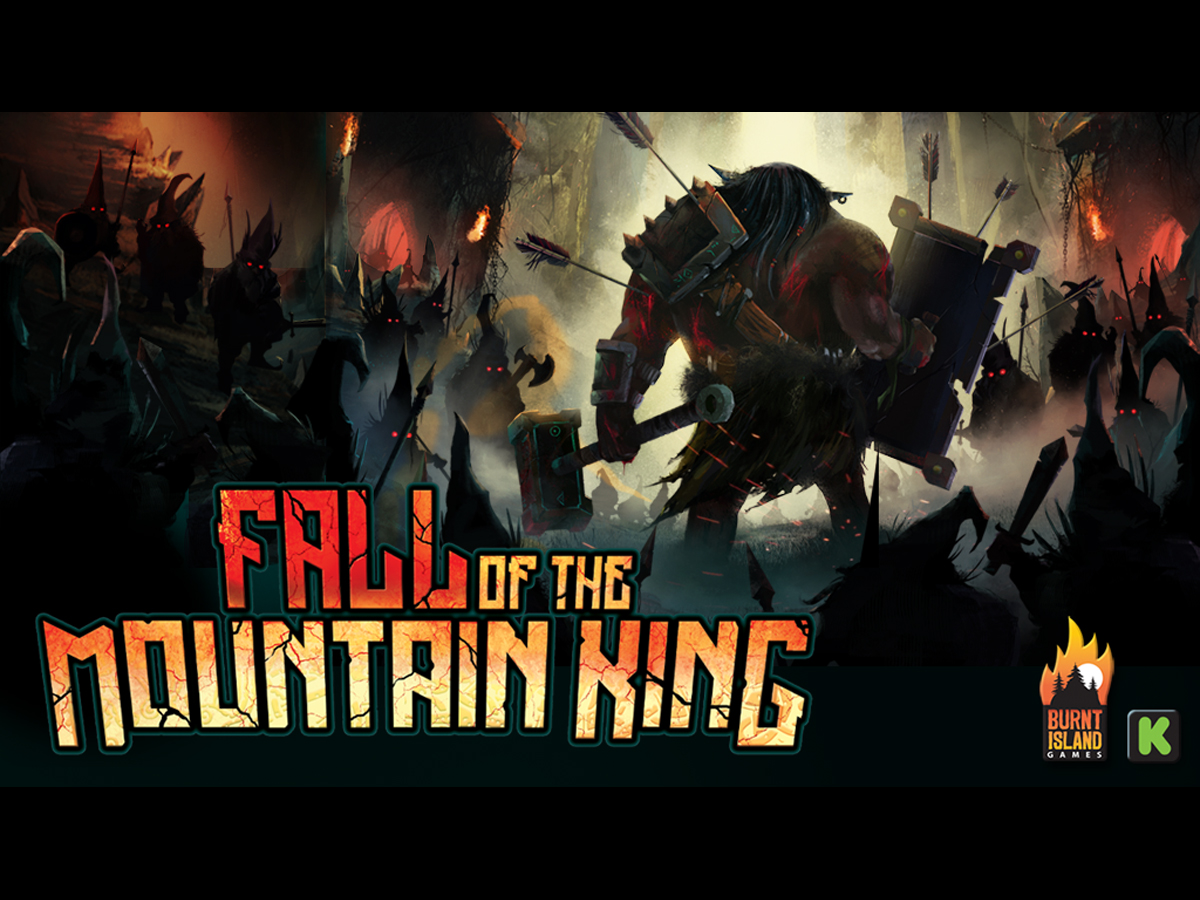The troll caverns are being invaded by gnomes—take up your positions and hold them off as well as you can!
What Is Fall of the Mountain King?
Fall of the Mountain King is a prequel to In the Hall of the Mountain King, for 1 to 5 players, ages 14 and up, and takes about 30 minutes per player to play. It’s currently funded on Kickstarter (and has been hitting stretch goals), with a pledge level of $95CAD (about $79USD) for a copy of the game. There’s also a pledge tier that includes In the Hall of the Mountain King, though I’ll note that this is not an expansion so the two games are both standalone.
Fall of the Mountain King was designed by Adam Daulton and published by Burnt Island Games, with illustrations by Fahed Alrajil. (The box cover was illustrated by Xavier Cuenca.)
New to Kickstarter? Check out our crowdfunding primer.

Fall of the Mountain King Components
Note: My review is based on a prototype copy, so it is subject to change and may not reflect final component quality.
Here’s what will come in the game:
- Cavern board
- Gnome Wheel board
- Clan board
- 28 Champion cards
- 73 Ancestry cards
- 5 Starting cards
- 14 Champion tags
- 7 Vote tiles
- 12 Great Hall tokens
- 12 Desperation tokens
- 30 Gnomes
- Gnome Swarm
- Wheel Pawn
- First Player marker
- 7 Gate cards
- 5 Player Component sets, each including:
- Supply track
- 2 Lair tiles
- 5 Champions
- 2 Player markers
- 13 Influence markers
- 25 Trolls
- 30 Ancestry cubes
Kickstarter backers will get some upgraded components compared to the planned retail edition: the trolls, champions, gnomes, and gnome swarm will all be miniatures in the Kickstarter edition; the retail edition will have troll and champion meeples, and wooden discs for the gnomes. Both the champion miniatures and meeples have a notch that fits the champion tags. (The prototype just used plastic stands for the champions.) The prototype also came with components for 4 players only, but the finished version will have 5 sets of player components. Much of the artwork in the prototype is also preliminary; you can see more updated versions on the website. Finally, the Kickstarter edition will include GameTrayz for the inserts to make the game easier to set up and keep organized.
There are a lot of little wooden (and/or plastic) bits in the game: each player will have several big piles of trolls, influence markers, and ancestry cubes. I haven’t included detailed photos of most of these components because I know the prototype and finished product will differ in quite a few ways, so it’s best to refer to the Kickstarter page if you want to see what things will look like.
Most of the cards in the game are pretty large: the champions cards are oversized cards that showcase the artwork nicely (and have room for influence tracks and descriptions of the abilities), and the ancestry cards are large squares. (The gate cards are half-sized cards.) Between the large cards and the piles of bits, you’ll need a good amount of table space for this one, especially at a full player count. I think the ancestry cards could have been a smidge smaller without losing any legibility, since those will take up a lot of space on the table.
The illustrations look great—even the prototype looked pretty nice, with the various colors and icons representing the different troll clans in the caverns, but the finished map looks even better with little details added. The board itself is double-sided, with different layouts depending on player count.
How to Play Fall of the Mountain King
You can download a draft of the rulebook here.
The Goal
The goal of the game is to score the most honor (points) by the end of three waves of invasions.

Setup
The main board is set up as follows: shuffle the Great Hall tokens and then place one face-up in each Great Hall. Place the Clan board nearby, shuffle the vote tiles, and place one face-up on each row. Shuffle the I/II champion cards and lay out a number face-up (depending on the player count).
Seed the board with gnomes by shuffling the gate cards, drawing one more than the number of players, and adding a gnome to a gate cavern in each of those clans. Then draw one more card and place the swarm at that gate. Shuffle the gate cards back together, and then place a number of them next to the door face-down. Make a supply of ancestry cards, desperation tokens, gnomes, and the champion tokens.
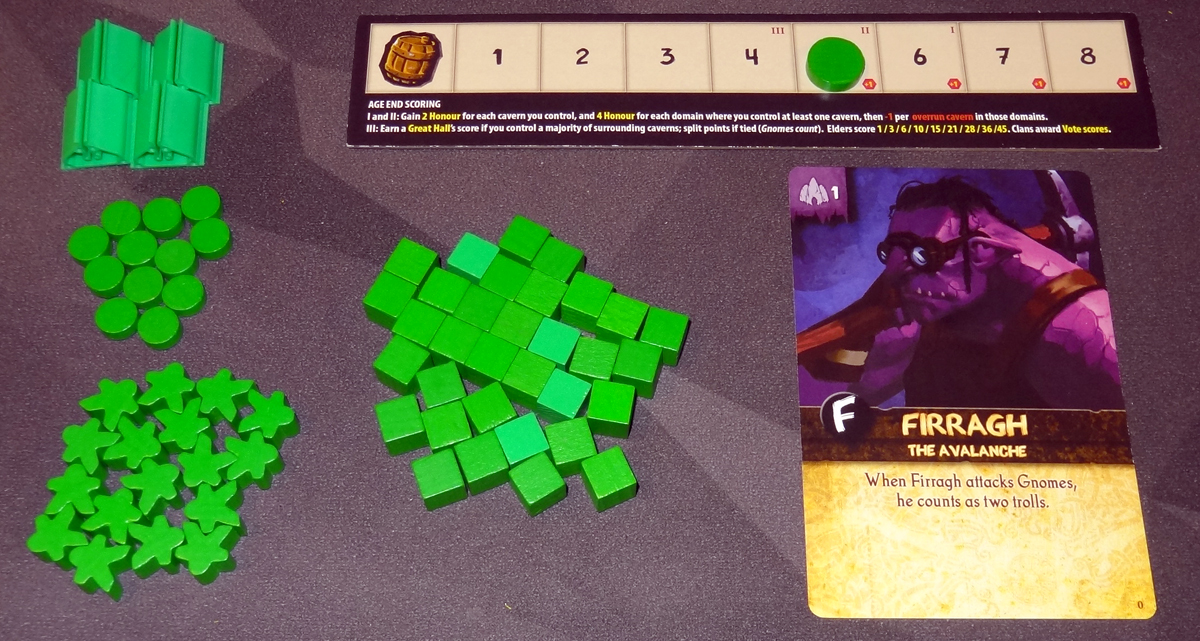
Each player gets a set of components in their color: trolls, champions, influence markers, ancestry cubes, and a few other things. One player token goes on the supply track and the other is for the scoring track. One influence cube is placed on the side of the Gnome Wheel. Pick a starting player and give them the start player marker. In turn order, each player places their two lairs on a pair of spaces on the board—they’re marked with letters. Each lair gets 3 trolls, and players also add 1 troll adjacent to each lair in a gnome-free cavern. Everyone draws a champion card from the 0 deck. Some champions have letters on them—in that case, find the matching champion token and add it to a champion pawn, placing it with one of your trolls on the board. You immediately gain votes on the clan board according to the number and icon shown at the top left.
Each player also gets a starting ancestry card, with 6 spaces showing various icons.
Gameplay
In each of the three waves, players will build their ancestry, then engage in battle, and then the gnomes invade.
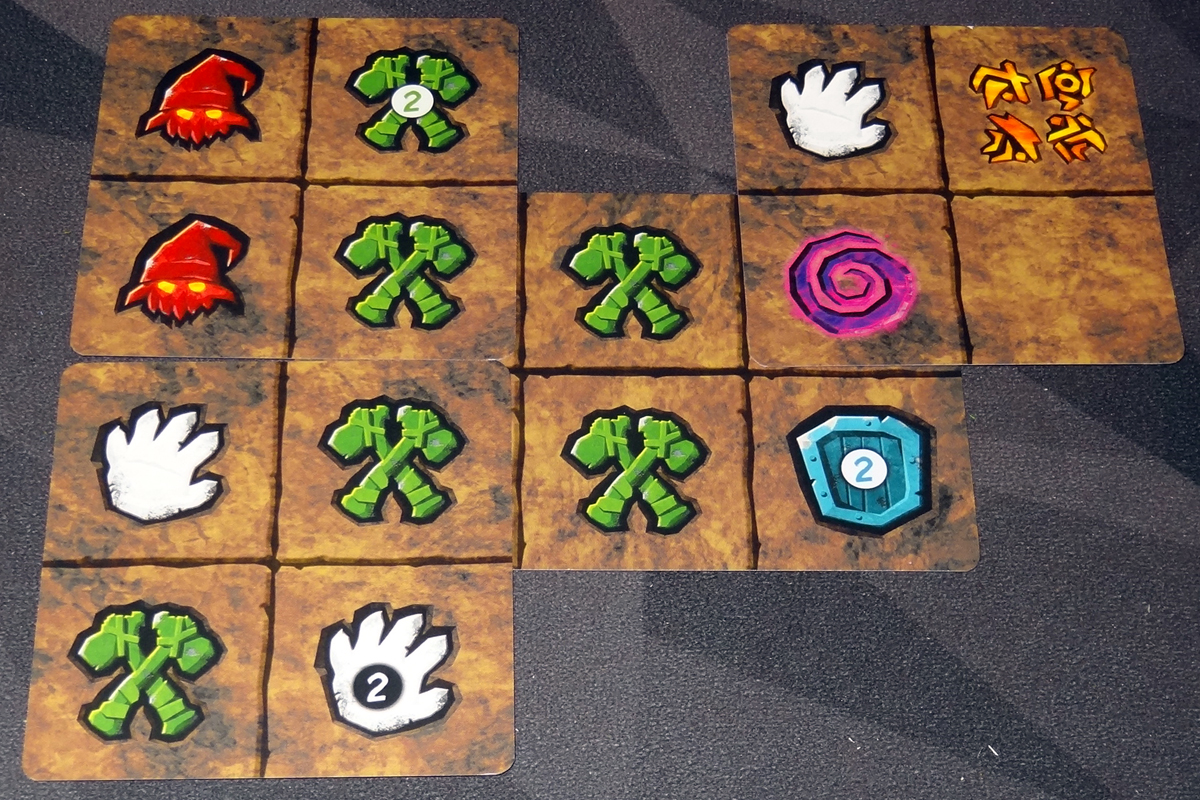
When the game begins, each player will have a 2×3 card with some action icons on it. Every player draws 4 ancestry cards from the deck. Everyone places one in their tableau, passing the rest to the next player, and repeating until each player has added 3 cards—the last card is discarded. When adding cards, cards may not be rotated (all icons must be oriented the same way), and each card has to overlap at least one square on an existing card. Also, the Elder symbols (the gold icons) cannot be covered. Your total ancestry area must fit in a 6×6 grid and nothing can extend beyond that.
After everyone has added 3 cards, the battle phase begins. Players will take turns spending supplies and taking actions until nobody has actions left. You get 6 supplies in the first wave, 5 in the second, and 4 in the third. In addition, you get one supply for each barrel icon in your ancestry. Finally, you may use wild symbols (the purple swirl) in your ancestry as supplies at this time, covering them with an ancestry cube to indicate that they’ve been used. For each supply fewer than 8, you take one desperation token.
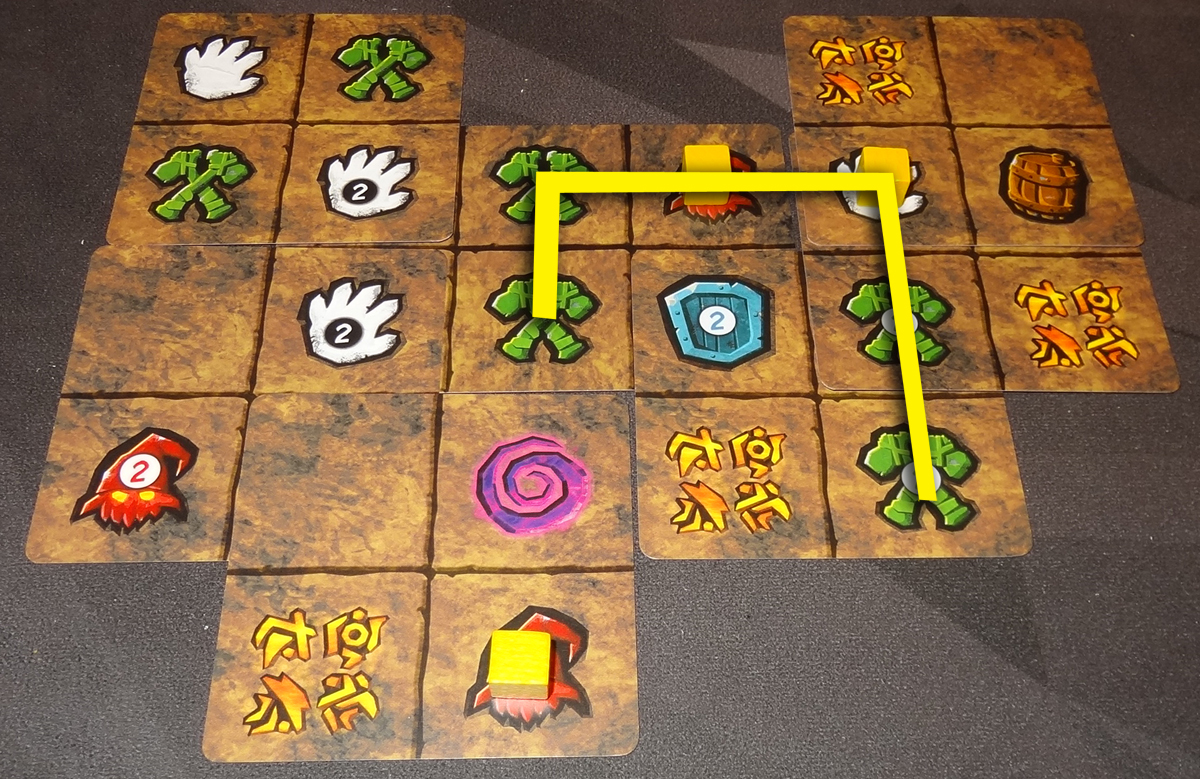
On your turn, you spend one supply and you may take either 2 weak actions or 1 strong action. Some icons in your tableau have “2” on them. A weak action is a single action without a 2; a strong action is taking an action that has a value of 2 or more, whether by using icons with a 2 or by chaining together adjacent icons.
Each time you use an action in your tableau, you cover it with an ancestry cube. When you take a strong action, you may chain together any number of adjacent icons of the same type, adding all their values together. In addition you may also chain through spaces that already have cubes on them. In the example above, the gnome and influence icons already have cubes on them, so this player could chain together the four advance icons to take a bigger strong advance. Wild icons can be counted as any action.

Here are the available actions: Advance, Bolster, Influence, and Gnome.
Advance (green hammers): choose one cavern, and move that many trolls into it—you can move any distance through caverns that you control (you have a majority of trolls in it) but must stop in caverns that are empty, controlled by other players, or occupied by gnomes. If you end movement where there are gnomes, you reveal their values: if you have at least that number of trolls in the cavern, you remove them and gain that much honor. You also place the gnomes next to the gnome wheel, advancing the pawn one space for each gnome defeated (which may trigger other effects). Otherwise, your trolls retreat to one of your lairs; if there was only one gnome, you add another gnome. Any time you seize control of a cavern from another player or gnomes, you also get one vote from that clan on the clan board.
Bolster (blue shields): choose one cavern that you dominate (you’re the only player present) and add that many trolls to it from your supply. You may always bolster in your lairs even if they’re empty.
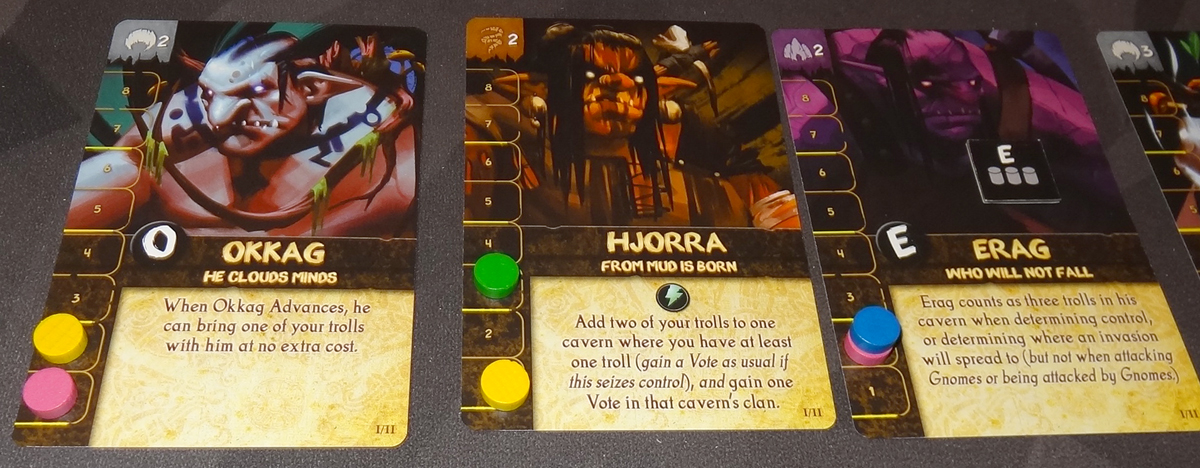
Influence (white hand): choose one of the displayed champions, and add that many influence to the track. If you are the first to influence a champion, you get 1 extra influence.

Gnome (red gnome): you may advance the pawn on the Gnome Wheel clockwise up to the value of your action. Then, do these in order:
- Scout: peek at one face-down gnome token (if any) on the board, and peek at one of the gate cards. You may move the swarm token up to 2 gates in either direction.
- If the pawn passed either of the two “tripwires” on the wheel, then activate those. The boost tripwire on the left advances your influence token one space on the boost. The breach tripwire causes a gnome invasion of at least 2 gnomes, plus an additional gnome for every pair of gnomes placed next to the wheel from battles (rounded up). These use the regular invasion rules—more on that later—except that any trolls defeated by these gnomes do not score any honor points. (The gnome tokens are then mixed back into the supply.)
- Take the action that the pawn landed on. These include influence, bolster, moving trolls—with some slight modifications from the regular versions of the actions—and gaining points.
You may also boost actions to increase their values. Weak actions may be boosted by spending desperation tokens—the value of the action increases but it still counts as a weak action. Strong actions may be boosted by spending extra supplies.
The battle continues until all players have passed, usually because they’ve run out of supplies or actions.
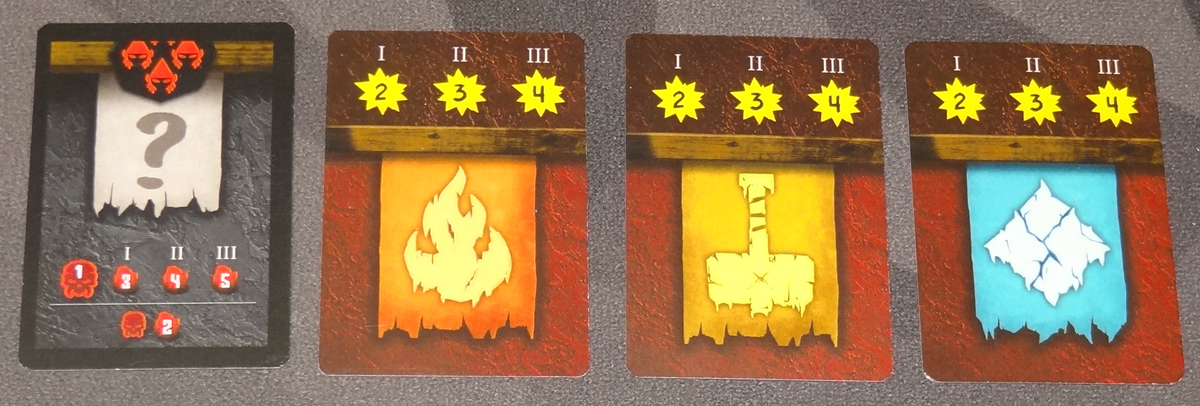
Then it’s time for the invasion! First, the gnomes entrench: any cavern with exactly one gnome in it gains an additional gnome. Then, you reveal the gate cards one at a time. Move the swarm to that gate, and then a number of gnomes enters the caverns (based on the wave). Gnomes always try to go to the gnome-free cavern with the fewest trolls, taking the shortest possible path there through other caverns with gnomes. If they can’t get to an empty cavern and end with trolls, each gnome will defeat one troll (and then remove itself). Players score points when their trolls are defeated in battle, but you gain the most honor by falling first.
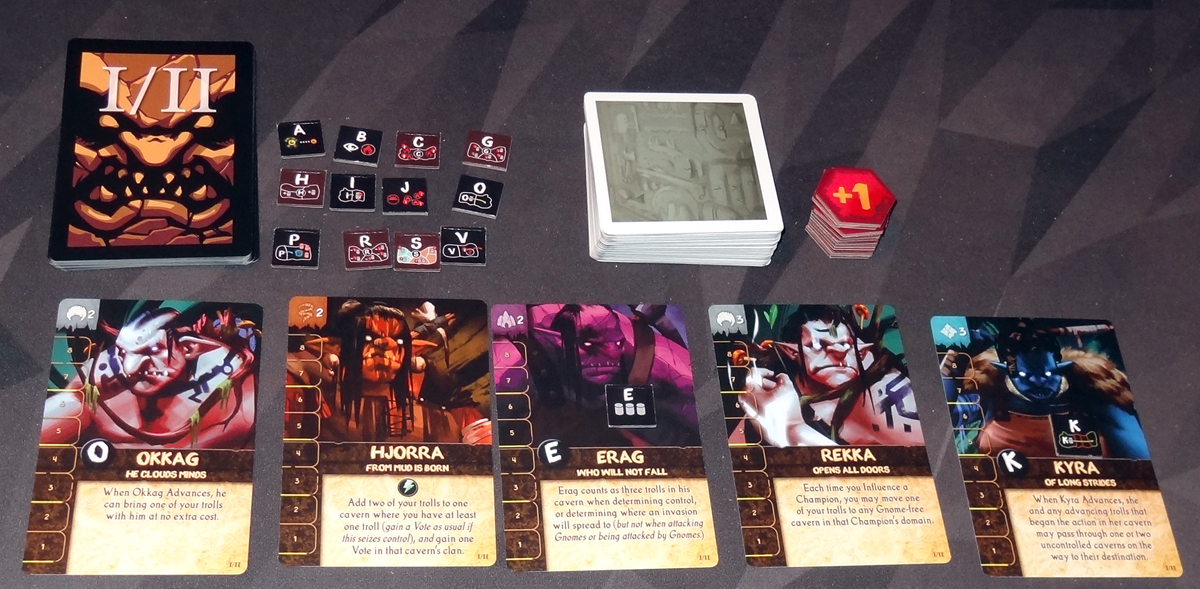
After resolving all of the gate cards and invasions, the champions are awarded. The player with the most influence on a champion gains the votes indicated at the top of the card and the champion itself. Other players with influence on that card get a consolation prize: either 1 vote in that clan, or 1 point for each of the yellow lines passed on the influence track. Some champions will have letter tags and are added to the board; others grant the player abilities but do not actually have a presence on the board.
Finally, players score points. In the first two waves, players score points for controlling caverns. For each cavern you control, you score 2 points. For each domain where you control at least one cavern, you score 4 additional points. For each overrun cavern (one with gnomes) in a domain where you have any control, you lose 1 point.
Reset for the next wave: clear the ancestry cubes from your tableau, shuffle and place new gate cards and champions, and discard any remaining desperation tokens. Pass the starting player token.
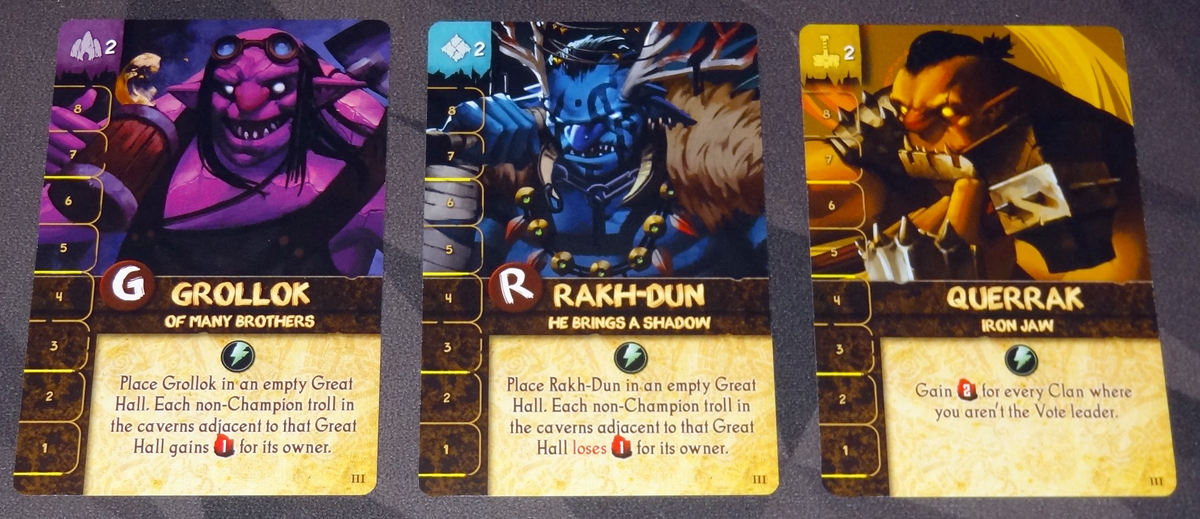
Game End
The third wave is a little different. First, the champions in the third wave mostly involve scoring—some are placed into great halls and score points that way, and others have to do with the clan board.
Instead of scoring for caverns, now you score for the great halls. Whoever controls the most caverns surrounding each great hall scores the honor for that hall; if there’s a tie for most caverns, the tied players split the points. Note that gnomes could also control caverns, so it is possible for nobody to score for a great hall.
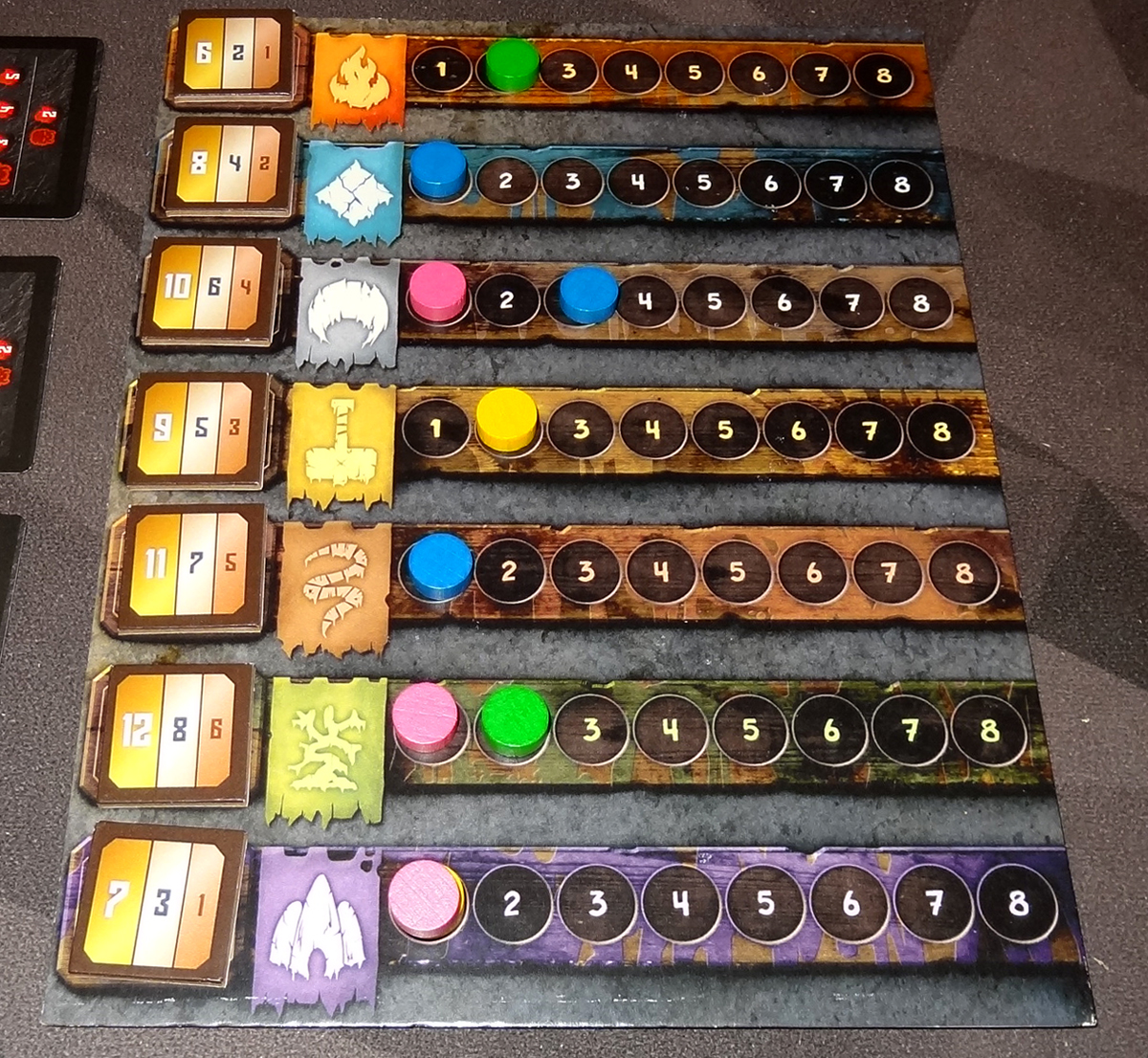
You also score points for the clan boards. Each clan awards points for first, second and third place. (In a 3-player game, you don’t award 3rd place.)
Finally, you score points for elder symbols in your tableau: the more you have, the more points you score.
The player with the most honor wins. If there’s a tie, the tied player who is leading in more clans on the clan board wins.
Why You Should Play Fall of the Mountain King
Fall of the Mountain King is a prequel to In the Hall of the Mountain King, though the two games are only connected by the theme rather than gameplay. While you and your fellow trolls battle the gnome invasion, you know that any success will only be temporary: it’s right there in the title of the game. Apparently, seeking votes in the various clans and jockeying to surround the most important great halls distracts the trolls just enough for the gnomes to make inroads into the caverns—maybe if you’d all learned to work together instead, troll-kind wouldn’t have to return, generations later, to reclaim their ancestral homes. At any rate, one of you can celebrate a brief, shining victory before you’re finally overrun by gnomes and flee these caverns.
It’s a curious mix of several different mechanics: there’s area control, but you don’t really battle each other—you just try to outnumber other players, and battle the gnomes. There’s action management, since you only have so many supplies each round and you have to decide which actions to spend them on. But definitely the part I liked the most was the tableau-building for the ancestry, which presented a fun puzzle.
As you add new cards, each one has to cover at least one quadrant of an existing card. It reminded me a little of Squire for Hire, which also uses overlapping cards (though in that case there are items of different sizes). You have to decide which card you want to keep, what you’ll cover up, and where it leaves room for growth later. The elder symbols are a pain, because they can’t be covered up and they break up your chains for strong actions; if you place one close to the edge of your tableau then you won’t be able to build around it, and you may end up with symbols that get stranded from the rest. There are blank spaces on some of the cards, too, so trying to figure out how to use those so you can layer on top of them without covering up useful actions is also key.
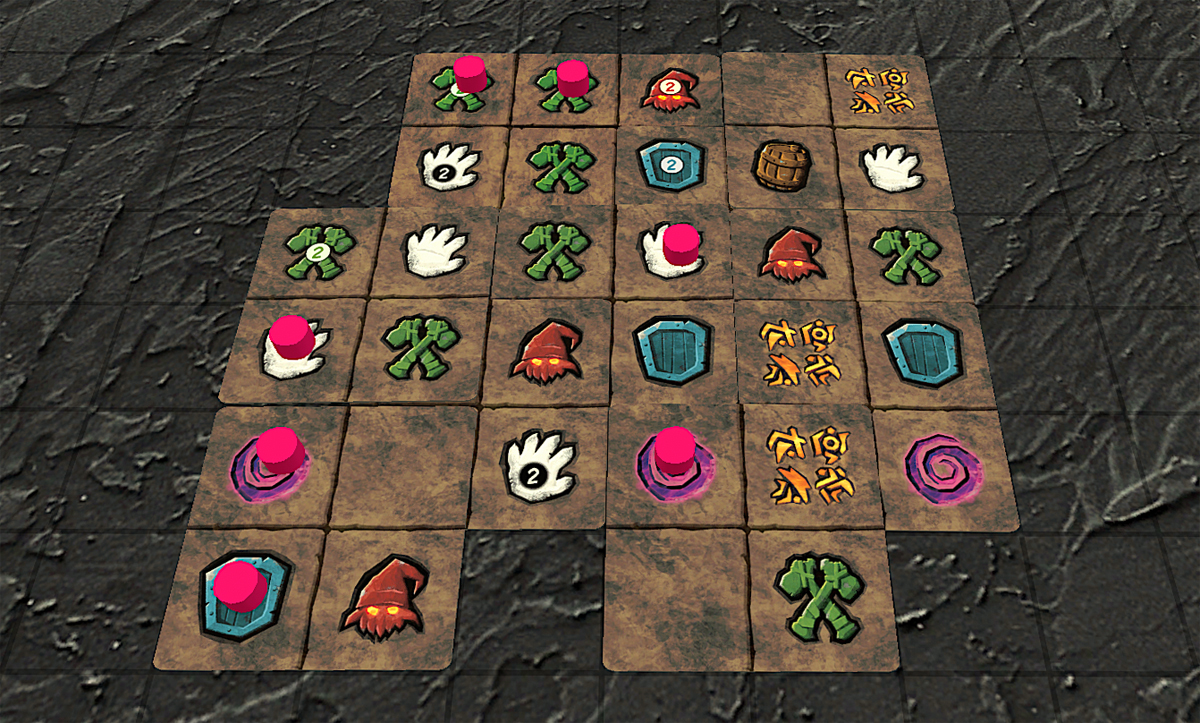
The other fun piece of the puzzle comes when you start taking actions—deciding the order that you’ll take actions, since you can chain through spaces that you’ve already used. So you might be able to spend a few turns taking some different weak actions, which then allow you to make a huge advance or influence. Juggling the number of supplies you have with the number of action icons in your tableau, and figuring out whether you can afford to do weak actions or strong actions, is a big part of the game. Not everyone will enjoy that and it can definitely lead to some analysis paralysis because of all the possibilities, but I really like the way that it forces me to think about how I build my ancestry. If you manage to build in a way that gives you a lot of action spaces, you might run out of supplies before you can use all of the actions available to you, especially since you get fewer and fewer supplies as your tableau grows bigger and bigger.
However, some of the other aspects weren’t quite as interesting to me. The Gnome Wheel in particular feels like it adds a good amount of rules overhead for a small benefit—though the rules for that have shifted slightly since the version that I played. In most of my plays, we did a pretty good job attacking the existing gnomes before they were able to entrench, and we also tended to congregate near the entrances so the invading gnomes didn’t stick around for long. That meant that the “scout” part of the gnome action let you peek at the gate cards but there weren’t many gnomes to spy on. In addition, most of the gnome wheel actions involve locations where gnomes (or the swarm) are present—the fewer gnomes are on the board, the more restrictive those actions are. While I do think being able to spy on where invasions are coming from is useful, the gnome action generally didn’t feel as valuable. The rule change I haven’t gotten to try was that attacked gnomes pile up by the wheel and add to breaches, which could result in more gnomes being on the board—that could make it a bit more interesting, but it’s still feels a little complicated.
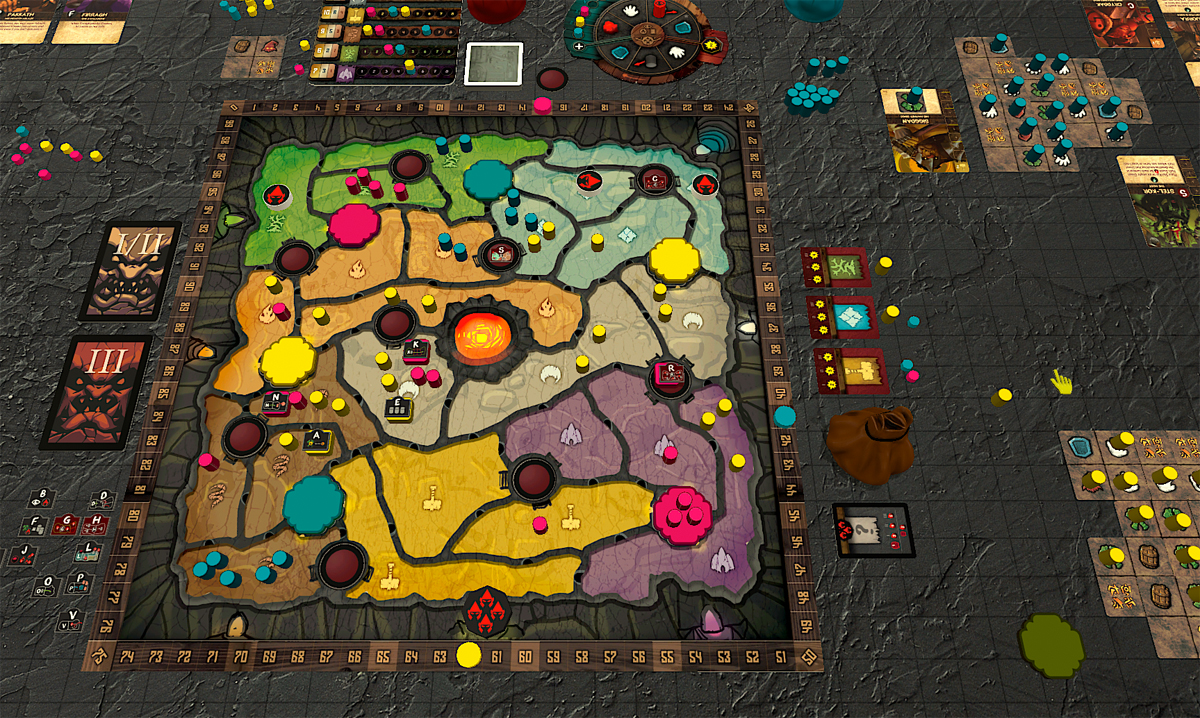
The game has lots of different ways to score points, which can also feel a little scattershot: you get points for stomping gnomes, points for getting the most votes for each clan (which, in turn, you do by stomping gnomes or crowding out other trolls), points for controlling caverns, points for dying in gnome attacks, and points for surrounding the great hall. You do get points for having elder symbols, although that almost feels more like a consolation prize for breaking your ancestry tableau and making it hard to use. All those different scoring systems—plus the fact that two significant sources of points only come at the very end of the game—can make it harder to tell at a glance who’s ahead, even though all that information is public.
I’ve played on Tabletop Simulator and the physical prototype with two different groups, and have gotten mixed reactions; everyone has liked the tableau building—or at least appreciated the agonizing frustration of trying to build your ancestry and receiving cards that just don’t quite fit. The area control (both for caverns and great halls) is solid but not necessarily innovative. Some of the other pieces felt a little less necessary to some players, though not everyone felt they were extraneous. In the end, I think it may depend on whether your group likes complexity or simplicity, since Fall of the Mountain King is more on the fiddly side of things, but it’s also not necessarily a heavy strategy game, either.
I do like the setting of the game, and the idea of this contest for glory even as my civilization is in decline, and the game looks great on the table—just make sure you have enough room for all of the ancestry tableaus! I’m also curious to try the original game now, too.
For more information or to make a pledge, visit the Fall of the Mountain King Kickstarter page!
Click here to see all our tabletop game reviews.
![]() To subscribe to GeekDad’s tabletop gaming coverage, please copy this link and add it to your RSS reader.
To subscribe to GeekDad’s tabletop gaming coverage, please copy this link and add it to your RSS reader.
Disclosure: GeekDad was loaned a prototype of this game for review purposes.
